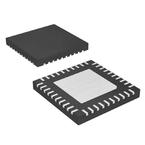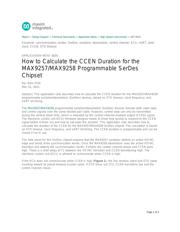herunterladen

Maxim > Design Support > Technical Documents > Application Notes > High-Speed Interconnect > APP 4934
Keywords: synchronization, serdes, SerDes, serializer, deserializer, control channel, ECU, UART, pixel
clock, CCEN, STO timeout
APPLICATION NOTE 4934
How to Calculate the CCEN Duration for the
MAX9257/MAX9258 Programmable SerDes
Chipset
By: Alex Shih
Mar 31, 2011
Abstract: This application note describes how to calculate the CCEN duration for the MAX9257/MAX9258
programmable serializer/deserializer (SerDes) devices, based on STO timeout, clock frequency, and
UART bit timing.
The MAX9257/MAX9258 programmable serializer/deserializer (SerDes) devices transfer both video data
and control signals over the same twisted-pair cable. However, control data can only be transmitted
during the vertical blank time, which is indicated by the control-channel-enabled output (CCEN) signal.
The electronic control unit (ECU) firmware designer needs to know how quickly to respond to the CCEN
signal before it times out and how to calculate this duration. This application note describes how to
calculate the duration of the CCEN for the MAX9257/MAX9258 SerDes chipset. The calculation is based
on STO timeout, clock frequency, and UART bit timing. The CCEN duration is programmable and can be
closed if not in use.
The data sheet for this SerDes chipset explains that the MAX9257 serializer detects an active VSYNC
edge and sends three synchronization words. Once the MAX9258 deserializer sees the active VSYNC
transition and detects the synchronization words, it enters the control-channel phase and CCEN goes
high. There is a brief delay of T1 between the VSYNC transition and CCEN transitioning high. The
electronic control unit (ECU) is allowed to communicate when CCEN is high.
If the ECU does not communicate while CCEN is high (Figure 1), the link remains silent and STO starts
counting toward its preset timeout-counter value. If STO times out (T2), CCEN transitions low and the
control channel closes.
Page 1 of 3





